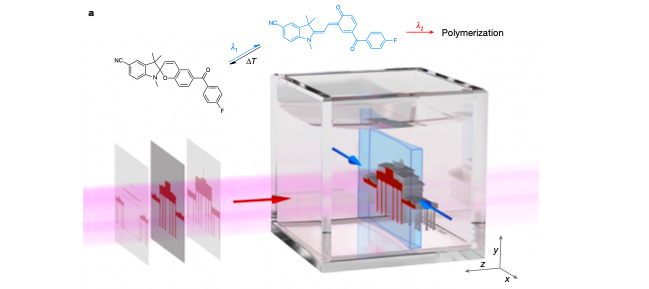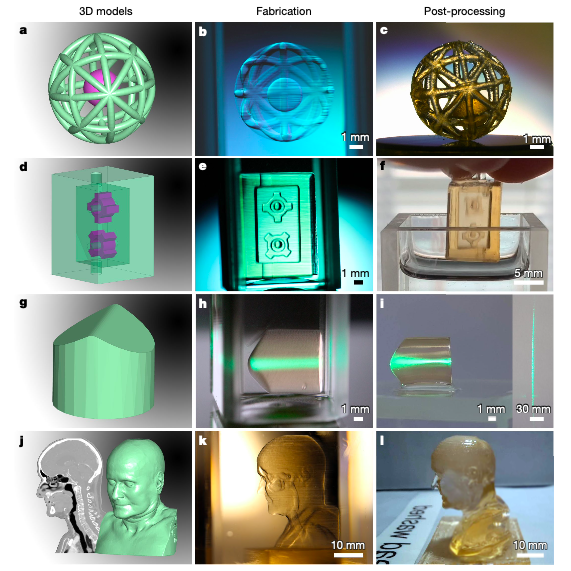Berlin startup xolo is in the process of launching xube, what could be considered the first commercially available volumetric 3D printer—if it gets off the ground. At the moment, the xube can be reserved for purchase, but is only meant as a test-bed machine to explore the possibilities of volumetric 3D printing, or “xolography” as the company refers to it.
 The xube 3D printer from xolo. Image courtesy of xolo.
The xube 3D printer from xolo. Image courtesy of xolo.While we’ve covered volumetric 3D printing in the past, all previous endeavors have been at the research stage. What makes the technology so fascinating and unique is the fact that it is theoretically capable of fabricating objects in mere seconds. It does this by curing photopolymer resin within a polymer vat from multiple angles, hardening it into a solid part all at once, as opposed to layer by layer. The exact method behind the volumetric technique varies depending on who’s doing it.
Xolography expands on other methods of volumetric 3D printing, such as that developed by Lawrence Livermore National Laboratory (LLNL), with the introduction of a laser beam. Whereas LLNL’s computed axial lithography (CAL) relies on a projector to cast a 3D model as a movie onto a rotating vat of photopolymer resin, Xolo directs a 405nm diode laser through lenses to create “a thin homogeneous light sheet.” Similar to the LLNL method, a projector then casts a video of slice images, representing every layer of a 3D model, onto the light sheet. Meanwhile, the vat of resin is moved away from the projector, while the light sheet activates a thin layer of photoinitiators in the resin, which absorb the projector beams and polymerize into a solid object.
 “Rendered illustration of the printing zone and associated photoinduced reaction pathways of the DCPI.” Image courtesy of Nature.
“Rendered illustration of the printing zone and associated photoinduced reaction pathways of the DCPI.” Image courtesy of Nature.The inventors of xolography describe the process in this way in a recent article for Nature:
[W]e [use] two intersecting light beams of different wavelengths to solidify localized regions. This approach, known as dual-colour photopolymerization (DCP)… Curing is mediated by a two-colour photoinitiator added to the resin, which is activated by a first wavelength, while absorption of the second wavelength either (1) initiates or (2) inhibits photopolymerization.
Key to the process is the use of a dual-color photoinitiator (DCPI), which absorbs light within the first 375 nm wavelength, while remaining transparent in the visible range. Photoswitching is then performed and the second wavelength from the projector (450 to 700 nm) excites a component of the photoinitiator that, in combination with the co-initiator, jump starts the polymerization process. Any material that is not hit with the visible light from the projector reverts back to its initial, non-activated state.
 “3D models (a, d, g, j) and photographs of printed objects before (b, e, h, k) and after (c, f, i, l) post-processing. a–c, Spherical cage with free-floating ball, 8 mm diameter. d–f, Encapsulated flow cell with rotary wheels, 9 mm in width. g–i, Aspherical Powell lens for laser line generation, 9 mm in width, as shown in the right inset. j–l, Anatomical model derived from the Manix CTA dataset, 30 mm in width.” Image courtesy of Nature.
“3D models (a, d, g, j) and photographs of printed objects before (b, e, h, k) and after (c, f, i, l) post-processing. a–c, Spherical cage with free-floating ball, 8 mm diameter. d–f, Encapsulated flow cell with rotary wheels, 9 mm in width. g–i, Aspherical Powell lens for laser line generation, 9 mm in width, as shown in the right inset. j–l, Anatomical model derived from the Manix CTA dataset, 30 mm in width.” Image courtesy of Nature.Volumetric 3D printing compares to what is now more traditional vat photopolymerization technology like stereolithography (SLA) or digital light processing (DLP) which cure resin point by point, in the case of SLA, or layer by layer, in the case of DLP. In turn, it’s possible to produce complete objects in even shorter periods of time than with continuous-DLP, what currently represents the cutting edge of vat photopolymerization technology from companies like Carbon, EnvisionTEC, 3D Systems, Carima or Azul 3D.
#xolography is not only print speed, it also operates at the other end of the spectrum regarding resin viscosity compared to SLA and DLP. https://t.co/Gt47WiiTh9 pic.twitter.com/Tf4QPuCg1g
— xolo (@xolo3D) December 26, 2020
Xolography is able to print at speeds of 104 to 105 higher than two-photon photopolymerization, while at the same scale as CAL. The authors of xolo’s Nature article believe that speed will increase as laser sources and photoiniators with faster thermal relaxation are explored.The build volume of the xube is 50 x 70 x 90 mm (1.97″ x 2.76″ x 3.54″) and the company claims it can print objects in two seconds to five minutes with a max resolution of 30 microns in the XY-axes and 50 microns in the Z.
 A dental model 3D printed with xolography. Image courtesy of xolo.
A dental model 3D printed with xolography. Image courtesy of xolo.As novel as it might be, volumetric 3D printing is expected to impact the larger polymer 3D printing industry, according to SmarTech’s fourth annual market study on Polymer Additive Manufacturing Markets. Of course, it will only represent a small piece of the $55 billion polymer 3D printing is projected to generate by the end of the decade, but xolo represents the earliest iteration of a technology that could disrupt the industry altogether.
Subscribe to Our Email Newsletter
Stay up-to-date on all the latest news from the 3D printing industry and receive information and offers from third party vendors.
You May Also Like
Printing Money Episode 17: Recent 3D Printing Deals, with Alex Kingsbury
Printing Money is back with Episode 17! Our host, NewCap Partners‘ Danny Piper, is joined by Alex Kingsbury for this episode, so you can prepare yourself for smart coverage laced...
Insights from Cantor Fitzgerald on AM’s Q1 2024 Landscape
A recent survey by Cantor Fitzgerald sheds light on the persistent challenges within the additive manufacturing (AM) industry in the first quarter of 2024. Based on responses from 38 industry...
3D Printing Financials: Xometry’s Scaling up and Strong Start to 2024
Xometry (Nasdaq: XMTR) kicked off 2024 with strong results, boosting its marketplace and technology to new heights. Both revenue and gross margin soared, fueled by an expanding global network of...
3D Printing Financials: Desktop Metal Targets Recovery Amid Net Losses and Revenue Downturn
Despite facing a decline in revenue and the persistent challenges of a tight economic climate, Desktop Metal (NYSE: DM) is making strides toward operational efficiency. The first quarter of 2024...
































